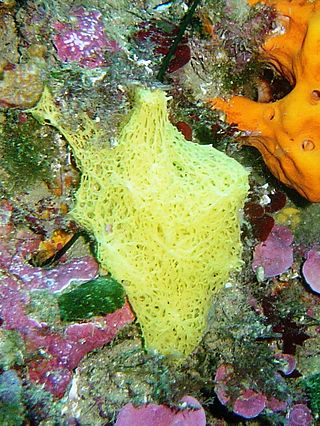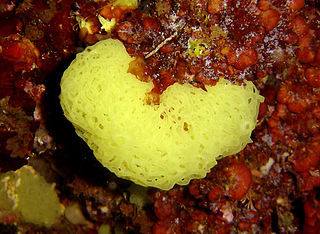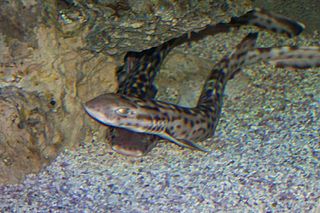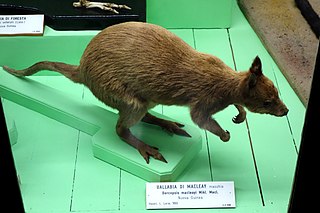
Clathrinidae is a family of calcareous sponges in the order Clathrinida. It contains the following genera:

Clathrina is a genus of calcareous sponge in the family Clathrinidae. Several species formerly in Clathrina were transferred to the newly erected genera Arturia, Ernstia, Borojevia, and Brattegardia in 2013. The name is derived from the Latin word "clathratus" meaning "latticed".

Atelomycterus is a genus of coloured catsharks in the family Atelomycteridae.

The Australian marbled catshark is a coloured catshark of the family Atelomycteridae, found in the eastern Indian Ocean, endemic to Western Australia between latitudes 12 and 21°S, from the surface to 245 m (800 ft) deep. Its length is up to 60.0 cm, and it typically inhabits coastal waters with sandy or rocky bottoms.

Macleay's dorcopsis, also known as the Papuan dorcopsis or the Papuan forest wallaby, is a species of marsupial in the family Macropodidae. It is endemic to Papua New Guinea, where its natural habitat is subtropical or tropical dry forest. Being little threatened by habitat destruction, the International Union for Conservation of Nature has rated it as being of "least concern".

Dorcopsulus is a genus of small marsupials in the family Macropodidae, known as forest wallabies. They are native to rainforests and montane forests of New Guinea.
Hedleya macleayi is an operculate species of land snail in the family Pupinidae and the superfamily Cyclophoridae.
Bentosites macleayi is a species of air-breathing land snails, terrestrial pulmonate gastropod mollusc in the family Camaenidae.
Clathrina blanca is a species of Calcareous sponge in the genus Clathrina.
Clathrina chrysea is a species of calcareous sponge from New Caledonia. The species epithet refers to the light yellow colour of the sponge.

Clathrina clathrus is a species of calcareous sponge belonging to the family Clathrinidae.
Ascandra contorta is a species of calcareous sponge belonging to the family Clathrinidae.

Clathrina coriacea is a species of calcareous sponge belonging to the class Calcarea and family Clathrinidae. Species in the genus Clathrina are composed of calcium carbonate tube-like skeletons containing spicules. The sponge can be located in shallow waters widely distributed along North Atlantic coasts, as well as on other coasts.
Clathrina heronensis is a species of calcareous sponge fin the family Clathrinidae and found in the seas around Australia, and in the coastal seas of many islands to her north. It was first described by Gert Wörheide and John Hooper in 1999.
Clathrina laminoclathrata is a species of calcareous sponge from Australia. The species name is in reference to its unusual lamina.
Clathrina primordialis is a species of calcareous sponge from Croatia.

Ambassis macleayi, commonly known as Macleay's glassfish, Macleay's glass perchlet, Macleay's perchlet, reticulated glassfish, reticulated perchlet, or network perchlet, is a species of freshwater fish in the family Ambassidae. It is native to northern Australia and the trans-Fly River region of New Guinea. It is a fish with a vertically flat, narrow body and a standard length generally between 35 and 45 mm, with large specimens reaching 77 mm (3.0 in) long. It generally eats water fleas and other small invertebrates. This fish is considered to be a least-concern species according to the International Union for Conservation of Nature (IUCN), although it could suffer from habitat degradation due to feral pigs and invasive water plants such as the water hyacinth. The fish is suitable for aquarium use in tanks containing other non-aggressive species.
Clathrina arnesenae is a species of calcareous sponge from the Atlantic Ocean. It is named after Norwegian spongiologist Emily Arnesen (1867–1928).
Clathrina philippina is a species of calcareous sponges from the Philippines.






